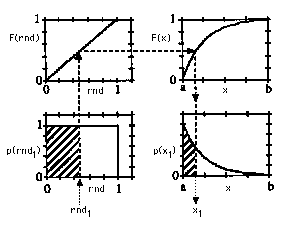The basic Monte Carlo technique
This section describes how the computer uses a random number generator to sample in an unbiased fashion values of a parameter x from a particular probability density function, p(x). In other words, if a large number of rnd values were used to choose a large number of x values and these choices of x were plotted as a histogram, the shape of the original p(x) would be reconstructed.
The computer's dice
The computer has a random number generator which can yield a random number, rnd, between 0 and 1 each time the computer calls that subroutine. This rnd is the computer's dice. The probability density function, p(rnd), is uniformly distributed between 0 and 1 with an assigned value of 1. The probability distribution function, F(rnd1), is defined as the integral of p(rnd) over the range of 0 <= rnd <= rnd1, and linearly increases from 0 to 1 as rnd1 increases from 0 to 1.
The desired p(x)
Suppose that we are interested in a probability density function, p(x), that describes the likelihood of the parameter x taking on a specific value, perhaps the specific value x1, between the limits a and b: a <= x <= b. The probability distribution function, F(x1), is defined as the integral of p(x) over the range of a <= x <= x1, and increases from 0 to 1 as x1 increases from a to b.
The connection between rnd and x.
The key to the Monte Carlo technique is to recognize that if one lets F(rnd1) equal F(x1), then a point of connection is made between p(rnd1) and p(x1). Random selection of rnd maps into a distributed selection of x that mimics the original p(x).
The following figure illustrates the connection between p(rnd1) and p(x1) via the equation of F(rnd1) equal F(x1):

click on figure to enlarge
A random number, rnd1, is chosen by the computer.
The value rnd1 points to a value F(rnd1).
The value F(rnd1) points to an equal value F(x1).
The value F(x1) points to a value x1.
This process is equivalent to equating the hatched areas under the p(rnd) and p(x) curves in the figure. The total areas under the p(rnd) curve from 0 to 1 and under the p(x) curve from a to b are both equal to 1.
In this way, a choice of rnd1 chooses a unique value x1. As a large number of random numbers, rnd1, are chosen, the set of associated x1 values will be sampled from p(x) in a non-biased way such that the histogram of chosen x1 values will mimic the original function p(x).
| |
Mathematically, the equivalence of F(rnd1) equal F(x1) can be stated as:

or more simply:

After evaluation of the integral above, the expression can be rearranged to solve for x1 in terms of rnd:

This expression function(rnd) can then be used to specify a choice of x for each random number, rnd, generated by the computer's random number generator. That's it!
back to article



